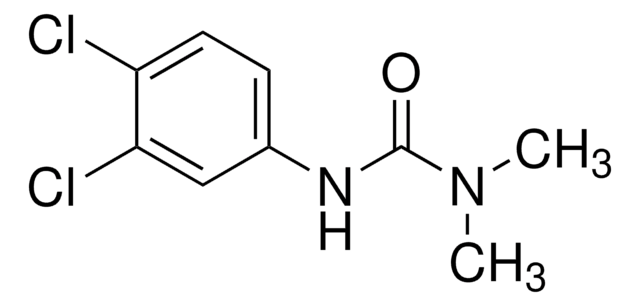271993
2,5-Dibromo-6-isopropyl-3-methyl-1,4-benzoquinone
Sinónimos:
2,5-Dibromo-3-methyl-6-isopropyl-p-benzoquinone, Dibromothymoquinone
Iniciar sesiónpara Ver la Fijación de precios por contrato y de la organización
About This Item
Fórmula lineal:
(CH3)2CHC6Br2(CH3)(=O)2
Número de CAS:
Peso molecular:
321.99
Número CE:
Número MDL:
Código UNSPSC:
12171500
ID de la sustancia en PubChem:
NACRES:
NA.47
Productos recomendados
Formulario
powder, crystals or chunks
mp
70-72 °C (lit.)
aplicaciones
diagnostic assay manufacturing
hematology
histology
temp. de almacenamiento
room temp
cadena SMILES
CC(C)C1=C(Br)C(=O)C(C)=C(Br)C1=O
InChI
1S/C10H10Br2O2/c1-4(2)6-8(12)9(13)5(3)7(11)10(6)14/h4H,1-3H3
Clave InChI
GHHZELQYJPWSMG-UHFFFAOYSA-N
Categorías relacionadas
Aplicación
2, 5-Dibromo-6-isopropyl-3-methyl-1, 4-benzoquinone has been used as a metabolic inhibitor of violaxanthin (V) cycle of Pelvetia canaliculata and is used as a photosynthetic electron transport chain (pETC) inhibitor.
Acciones bioquímicas o fisiológicas
2, 5-Dibromo-6-isopropyl-3-methyl-1, 4-benzoquinone acts as an inhibitor of respiratory and photosynthetic processes.
Código de clase de almacenamiento
11 - Combustible Solids
Clase de riesgo para el agua (WGK)
WGK 3
Punto de inflamabilidad (°F)
Not applicable
Punto de inflamabilidad (°C)
Not applicable
Equipo de protección personal
dust mask type N95 (US), Eyeshields, Gloves
Elija entre una de las versiones más recientes:
¿Ya tiene este producto?
Encuentre la documentación para los productos que ha comprado recientemente en la Biblioteca de documentos.
Activation of violaxanthin cycle in darkness is a common response to different abiotic stresses: a case study in Pelvetia canaliculata
Marin BF<
BMC plant biology (2011)
Jemaa Essemine et al.
Frontiers in plant science, 11, 1009-1009 (2020-08-01)
The present study reveals contrasting responses of photosynthesis to salt stress in two C4 species: a glycophyte Setaria viridis (SV) and a halophyte Spartina alterniflora (SA). Specifically, the effect of short-term salt stress treatment on the photosynthetic CO2 uptake and
Sousuke Imamura et al.
FEBS letters, 554(3), 357-362 (2003-11-19)
The expression of group 2 sigma factors is characterized in a cyanobacterium Synechocystis sp. PCC 6803 grown in culture, changing light conditions (white, red and blue light, and darkness), or the presence of drugs (rifampicin, chloramphenicol, DCMU, and DBMIB), and
Deepak Venkanna et al.
Frontiers in plant science, 8, 1347-1347 (2017-08-22)
The protein superfamily of short-chain dehydrogenases/reductases (SDR), including members of the atypical type (aSDR), covers a huge range of catalyzed reactions and
Chloroplasts extend stromules independently and in response to internal redox signals
Brunkard J O, et.al.
Proceedings of the National Academy of Sciences of the USA, 112, 10044-10049 (2015)
Nuestro equipo de científicos tiene experiencia en todas las áreas de investigación: Ciencias de la vida, Ciencia de los materiales, Síntesis química, Cromatografía, Analítica y muchas otras.
Póngase en contacto con el Servicio técnico







